Review: 2025 Porsche 911 Carrera GTS T-Hybrid Electrifies Potent Performance
Picking through the menus of the infotainment screen and digital instrument cluster of the 2025 Porsche 911 Carrera GTS T-Hybrid, I can configure the screens to see how much power is on boil and where it’s coming from. Not only that, but I can also see exactly how the 911’s first-ever hybrid system works in real time.
For the left side of the new, fully digital 12.6-inch instrument panel, I chose a display that shows the battery temperature and psi of turbo boost. In the center, I opt for the digital tachometer that replaces last year’s analog version. For the right side, I pick a torque gauge.
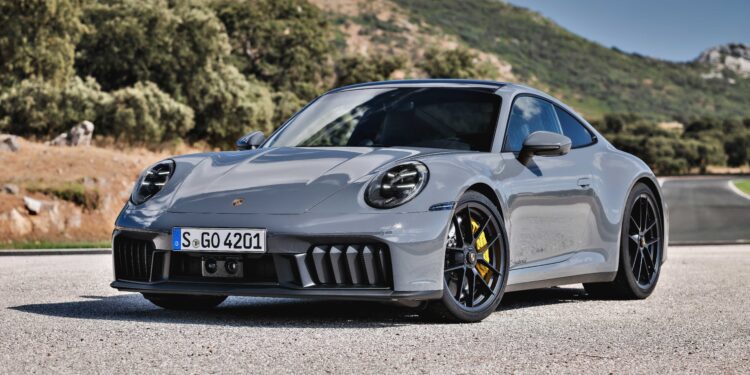

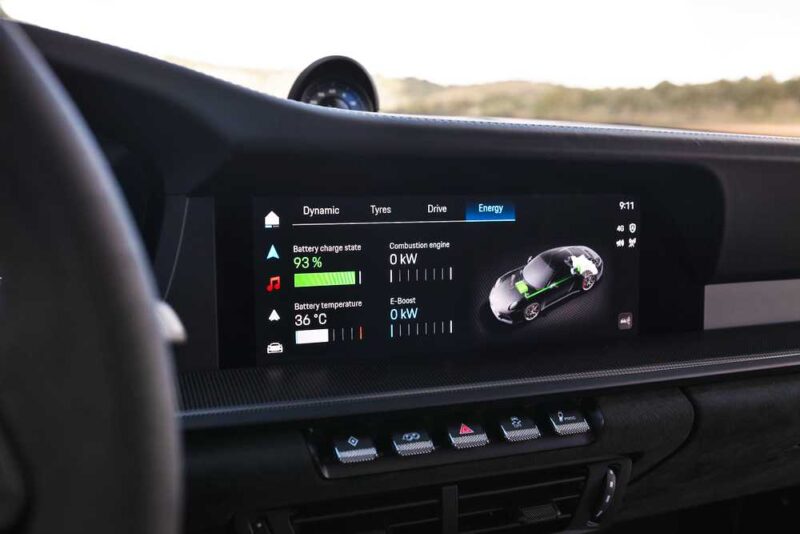
Moving over to the 10.9-inch touchscreen, I pick the Energy display nested under the Performance widget. It shows the state of charge for the battery and the current output of the combustion engine and electric motor in kilowatts.
All this information would be a novel curiosity most of the time, but here it shows the interplay of the electric motor, turbo boost, revs, and engine output. It reveals that the 911’s first hybrid system is incredibly well integrated and demonstrates the advantages the 992.2-generation GTS has over the outgoing 992.1 generation.
When my right foot twitches, I can see the electric motor react immediately, adding up to 53 horsepower and 110 pound-feet of torque to help the car accelerate. This motor is located within the eight-speed dual-clutch automatic transmission, and it never drives the car on its own. It’s not here to improve fuel economy, at least not significantly. Instead, it’s included to improve performance, provide torque fill as turbo boost builds, and help future-proof the 911 for European emissions regulations.
Shortly thereafter, the turbo catches up. The new 911 GTS T-Hybrid uses a larger 3.6-liter flat-six with a single turbo instead of a 3.0-liter engine with dual turbos. The major change, however, is the addition of another 20-kW electric motor located between the compressor and exhaust sides of the turbocharger. This motor helps the larger single turbo spool up quicker than the twin turbos of the last-generation GTS. That model took a little more than three seconds to achieve its full 18.6 psi of boost. The T-Hybrid’s turbo takes less than a second to spool up 26.1 psi.
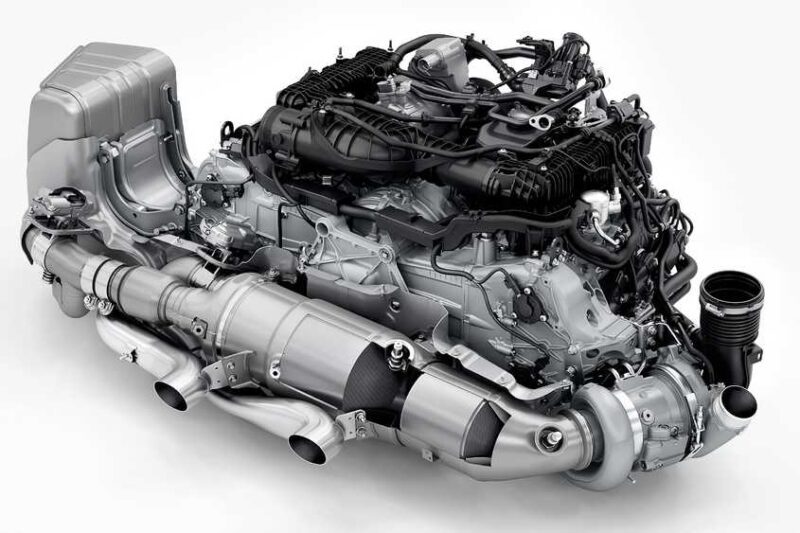
With more boost and displacement, the 3.6-liter engine makes 478 horsepower and 420 pound-feet of torque on its own. Add the motor’s contribution and total output is 532 horsepower and 449 pounds-feet of torque. That beats the last model by 59 horsepower and 29 pound-feet. When I keep my foot in the throttle, the flat-six revs freely up to 7,500 rpm, and the exhaust belts out its intoxicating raspy thrum accompanied by the whistle and chuff of the turbocharger.
The transmission fires through gears with urgency, and the car builds speed relentlessly. The 0-60 mph sprint flashes by in 2.9 seconds, according to Porsche, 0.3 seconds quicker than last year. However, a few launch control blasts show that the strong power makes it hard to get the wide rear tires to hook up and achieve that time. Were I to keep my foot in it, it would accelerate to 194 mph. That’s supercar territory.
EPA ratings of 17 mpg city, 24 highway, 20 combined are no better than the last model. However, the hybrid system is well-engineered and integrated. Throttle response is quicker, power is more robust, and the whole system adds only 103 pounds to the total weight of the car versus the 2024 model.
The modest weight gain means the 2025 911 GTS boasts the same confident, stable, and confidence-inspiring handling that has been a hallmark of the 992 generation since it arrived for the 2019 model year. With quick and direct steering that supplies a lot of road feel, it’s easy to control the GTS. Throw it into a corner and it takes a set, rotates willingly, and the 245/35R20 front and 315/30R21 rear Goodyear Eagle F1 Super Sport tires grip hard. Standard rear-axle steering makes it more stable mid-corner and shortens parking lot turns, while a standard limited-slip rear differential puts the power down effectively to rocket out of corners.
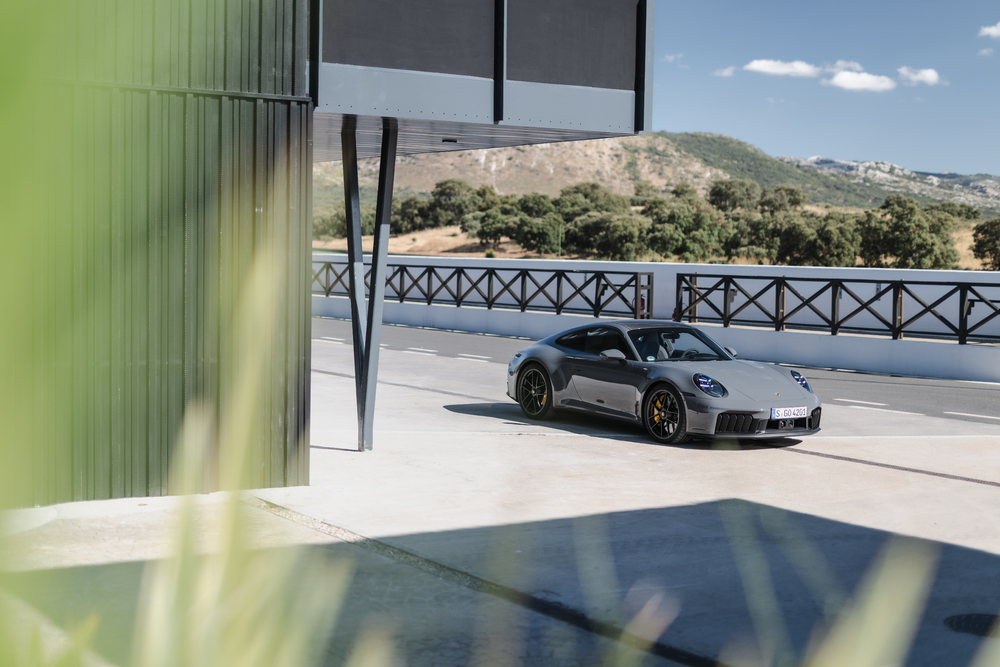
1 of 8

The 911 GTS comes standard with adaptive dampers and the PASM Sport suspension. Compared to the base and S models, the PASM Sport setup gets a 0.4-inch lower ride height, additional negative camber for a more tire contact patch in corners, and stiffer spring rates and rear helper springs that help keep the coil-over shocks seated at full suspension travel. This suspension makes for a firm but not punishing ride. Some may find it too firm and would be better served by choosing the no-cost regular PASM suspension that rides higher and has softer Tuning.
This test car also has the optional electro-hydraulically controlled active anti-roll bars. They respond quicker this year thanks to the hybrid system’s 400-volt electrical system, but I see no need for them. The 911 GTS has precious little body lean, and some body lean translates as feel in the corners.
My tester is also equipped with the $10,680 carbon-ceramic brakes. These massive binders employ 16.5-inch front rotors and 10-piston (!) calipers and 16.1-inch rear rotors and six-piston calipers. They’ll stand up to numerous track days with a firm pedal and no fade.
My tester also comes with the standard Sport Seats Plus. They’re wide enough or larger gentlemen and do a great job of keeping me in place in the face of lateral Gs, but they have only four-way manual adjustments, and their tall, rigid side bolsters become buns scrapers when getting in and out. Spend another $1,580 for the 14-way power-adjustable seats.

The rest of the changes for the 992.2 version of the 911 GTS are minor. The headlights now have LED matrix technology and incorporate the daytime running lights into a single unit. The taillights get a new look, and the fascias are more aerodynamic, especially up front, where Porsche adds active grille shutters and a continuously variable diffuser.
The 2025 911 Carrera GTS T-Hybrid starts at $166,895, including a $1,995 destination fee. That’s about $15,000 more than the 2024 model, which reflects both improved performance of the new GTS and Porsche’s recent effort to increase profit margins. Expect further price increases due to tariffs.
It costs a lot, but 911 GTS buyers get more than just a sports car. The first 911 hybrid tilts toward a supercar in its power and performance, and the new hybrid system is a big part of that additional power. It’s engineered as expected for the Porsche brand, adding minimal weight and working seamlessly. You can watch it all happen in real time if you pick the right displays for the dashboard screens, but mostly you’ll just enjoy feeling it doing its job.
First Drive: Six-figure Ford Mustang GTD Boasts Peak Pony Muscle
by Basem Wasef
in Ford News, Mustang, Reviews
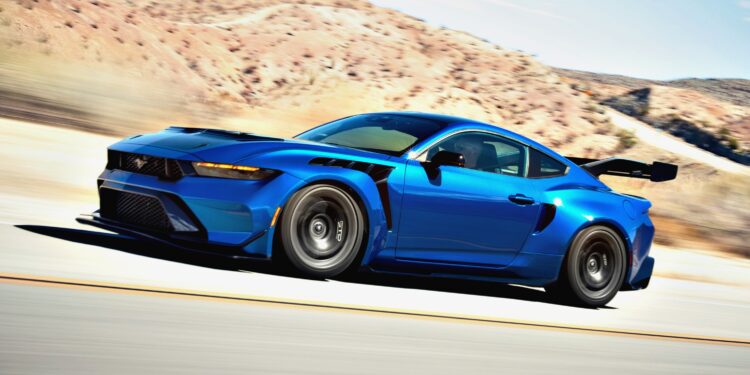
If you think spending Lambo money on a Mustang is madness, Jim Farley would like to have a word with you. The Blue Oval CEO’s fondness for the O.G. pony car makes the 7-and-sometimes-8-figure-per-year exec seem more like Joe Six Pack than a captain of industry.
But his ‘Stang fanboying comes from the heart: he restored a 1964 ½ basket case at 15, acquired a ’65 Shelby GT350 years later, and has tracked all manner of Mustangs in between. Farley’s championing of the platform is well documented and was perhaps most clearly expressed when he shielded the Mustang from extinction during Ford’s 2018 shift to building only trucks, crossovers, and SUVs.
The big boss also embiggened the Mustang by throwing the model into a slew of race series, most critically GT3, where the humble American pony car competes against nameplates like Aston Martin, Ferrari, Lamborghini, and McLaren. When contextualized against those ultra-fancy competitors, a heavily spoilered, flared, vented, and $325,000 Mustang GTD starts to make a tiny bit more sense.
“Mustang is the flagship race car of the Ford Motor Company, and pretty much any given weekend we’re racing one somewhere,” GTD chief program engineer Greg Goodall told duPont Registry at the vehicle’s media launch in Thermal, CA. “We’re competing against the exotic European carmakers. Why wouldn’t we compete with them on the road?”
The first goal when building the baddest ass Mustang in all the land was establishing a killer Nürburgring time. “You can’t just tell people we’re like Porsche,” insists Goodall, “you have to measure it in some way.” Hence, the sub-7-minute time target.
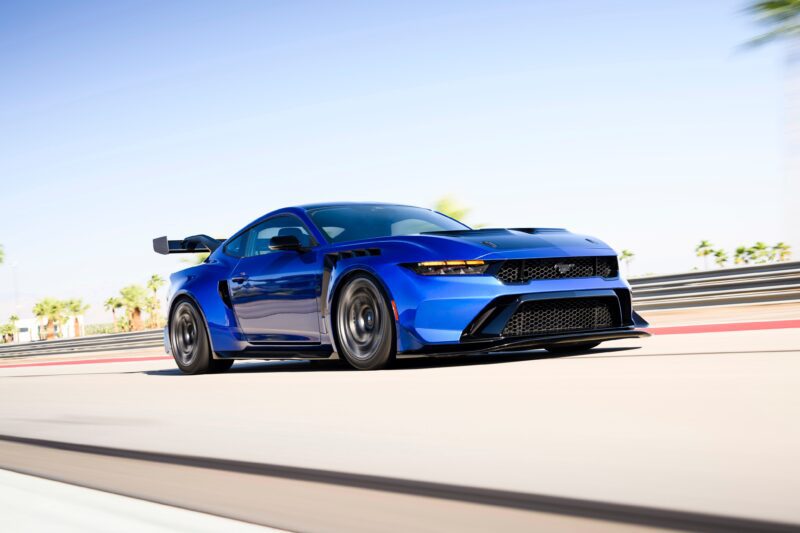
Things didn’t initially go as planned, as only three officially timed laps transpired in 2024 due to the weather at the 12.9-mile circuit. While an August run achieved 6:57.685, the team felt there was room for improvement, which inspired chassis, suspension, and aero tweaks, along with revisions to ABS and traction control tuning.
In May of 2025, Dirk Müller found 5.6 seconds, elevating the 815-horsepower muscle car’s 6:52.072 time just behind the Porsche 911 GT3 RS (6:49.328), Mercedes-AMG GT Black Series (6:48.047), and the Mercedes-AMG One (6:29:090). Even though GTDs are already in the hands of paying customers, Ford Performance says they’re still chasing a quicker lap time around the Eifel Mountain course.
Like that other performance-focused strain linked to international competition, the Ford GT, the GTD was executed through a deep collaboration with Multimatic. The transmogrification starts with a run-of-the-mill Mustang’s body-in-white that gets plucked from Ford’s Flat Rock, Michigan, plant to Multimatic HQs in Ontario.
The Mustang’s body-in-white is shipped without front fenders or a hood, which Multimatic replaces with a massively flared and vented pair of fenders and a carbon fiber hood with removable top grilles for track use. Deep surgery begins by plasma cutting and removing the second row, the rear floor, and the outer shell.
Much of that negative space gets filled with the Tremec 8-speed dual-clutch transaxle, which helps deliver near-perfect 50/50 weight distribution. Up front is an evolution of the Predator supercharged 5.2-liter V8 found in the GT500 and Raptor R, tuned to 815 horsepower and 664 lb-ft of torque. This application uses dry sump lubrication and drives power through a carbon fiber propshaft – all proper racecar stuff.
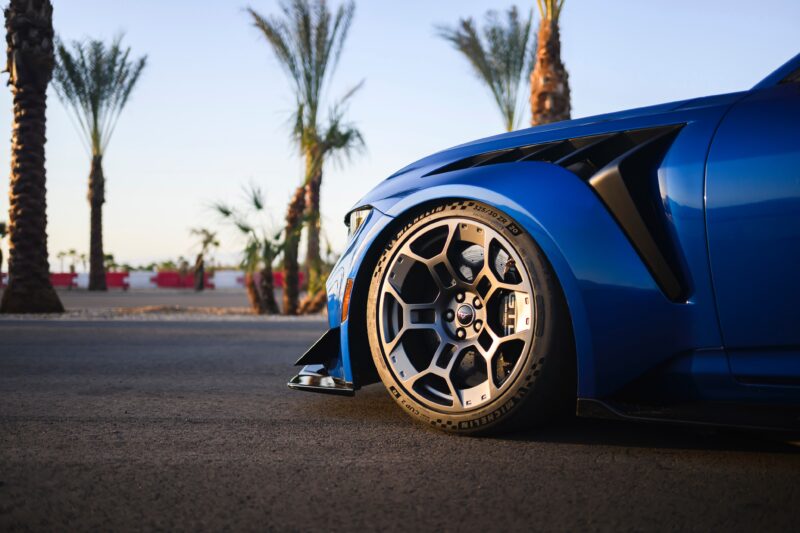
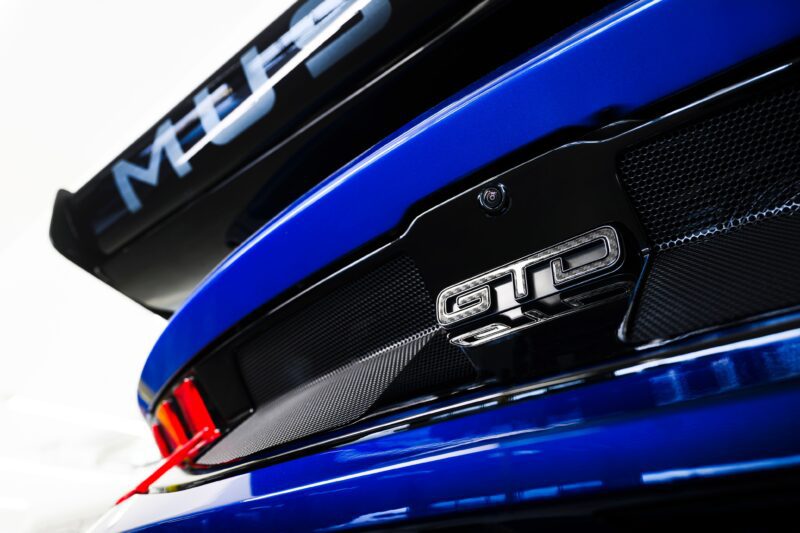
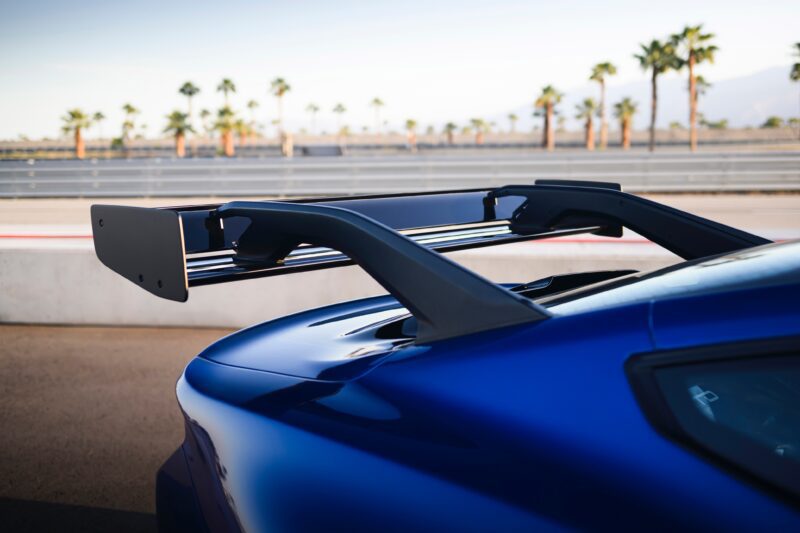
While the business may be in the front, the GTD’s party is definitely in the back. Due to the transaxle’s disruption of a space that was never intended to house it, Multimatic developed an inboard suspension system that leverages a similar setup to the late, great Ford GT’s. Using dual adaptive spool valve dampers, the suspension adjusts semi-actively within each drive mode. Also like the GT, a track mode (which requires the vehicle to be stopped and in Park to activate) drops the body dramatically in under 2.0 seconds, yielding a super low ride height and satisfyingly aggro wheel stance.
Incidentally, carbon fiber reinforcements mend the broken jigsaw puzzle of the GTD’s discombobulated rear end, lending it stiffer torsional rigidity than stock. They also crammed in heat exchangers to cool the transaxle, a massive active wing with DRS that mounts to the rear pillars, and the aforementioned pushrod suspension, which is visible inside the cabin through a Lexan window. Pro tip: Tilting the rearview mirror down while driving enables a clear view of the mesmerizing suspension kinematics. Don’t try this at home.

1 of 8

For all the visual theatre of the GTD’s flared, swollen, stanced, and steroidal body, the cabin is surprisingly – and disappointingly – normal. The usual Mustang bits abound, from the touchscreen display to the same HVAC implementation (which blows remarkably cold in 100+ degree weather, by the way) to the faux carbon fiber texture around part of the center console. Minor tweaks include the steering wheel’s adaptive cruise buttons, which have been repurposed to control the multi-stage traction control settings in Track mode.
Two days at the Thermal Club provide plenty of time to acclimate to the Alan Wilson-designed circuit in its maximum length, 5.1-mile IndyCar configuration, starting in Dark Horse Mustangs. Despite the annoyingly similar interiors, going from a $75,000, 500-horsepower Dark Horse to a $325,000, 815-horsepower GTD is like, well, going from a horse to a supercar.
The GTD’s supercharged V8 comes to life with a raw snarl, its titanium Akrapovič exhaust betraying its track-focused intentions. Surprisingly, though, it seems the supercharger whine has been quieted at speed. Despite this, there are a number of ways the GTD exceeds the GT3 race car. Though heavier, it also produces more power and boasts active aerodynamics and suspension. According to Goodall, the GT3 could outpace a GTD on smaller, more technical courses, though the GTD would likely get ahead on longer tracks.
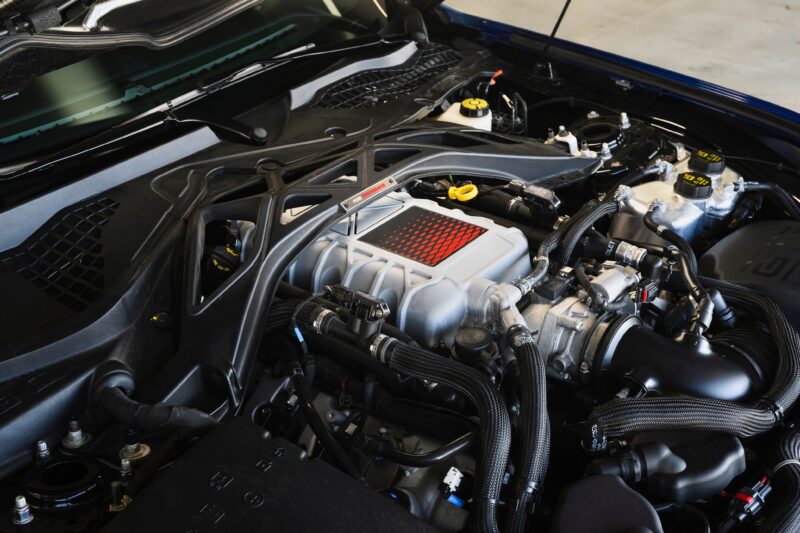
You’d never know the GTD weighs 4,386 lbs from the cradle of the specially developed Recaro driver’s seat; once accelerating, the V8’s tug is magnificent, the steering feel excellent, and the chassis and suspension remarkably agile. Overcook it into a corner, and a brake stab and steering adjustment tucks the ‘Stang back into form quickly.
This beast never feels like its mass is getting away from you, especially at higher speeds, since downforce escalates from 941 lbs at 125 mph all the way up to 1,951 lbs at 180 mph. Also commendable are the six-piston carbon ceramic Brembos, which produce powerful, easily modulated fade-free stops. Oh, and you can have any tire you want on the GTD… as long as it’s ultra-sticky Michelin Cup 2 Rs. As much as the GTD’s Hertz Rent-a-Car interior sends the wrong signals about its capabilities, its mercilessly aggressive bodywork and broad-shouldered stance sing to its true self.
And lest you suspect that well-heeled muscle car buyers will balk at the price, the order book is already full for the first two years of production. Fierce, controlled, and bombastic about performance, the GTD is the All-American M2 Browning .50 Cal to the GT3 RS’s Teutonic surgical scalpel. And if you’re wondering why Ford and Multimatic didn’t go even wilder with a full carbon fiber chassis, the answer is simple: it would no longer be a Mustang.
View All Ford Mustangs For Sale
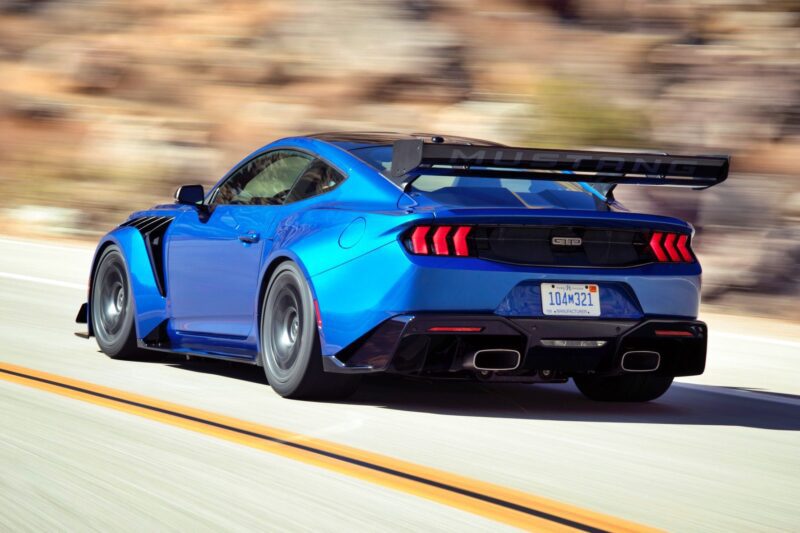
2025 Morgan Plus Four Review: A Timeless Reminder of Olde-School Driving Fun
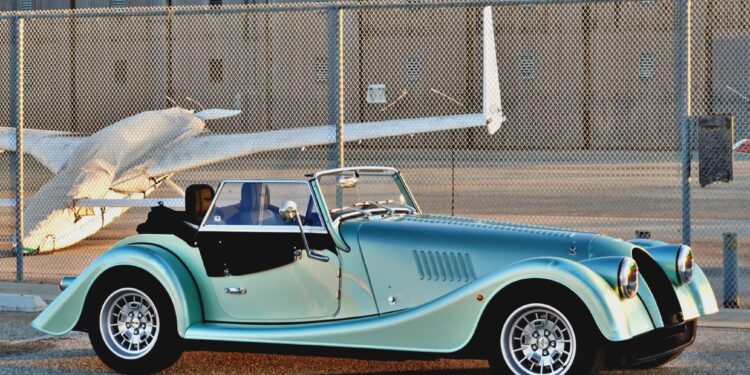
The last time British coachbuilder Morgan sold the historic Plus Four model here in the United States, in 2005, the chassis was literally made of plywood – or so the urban legend goes. In point of fact, Morgan always used a steel chassis from the Plus Four’s debut in 1950 all the way until the latest generation debuted in 2020.
But that rumor likely grew out of the fact that the Plus Four still uses ash wood for the body frame, even now in 2025, as Morgan begins to ship the latest generation to the United States complete with a BMW powertrain, Bluetooth connectivity, and a stretched design that fits more people more comfortably – all riding on a new aluminum chassis structure beneath the skin. Super.
Unfortunately, in a baffling decision, Morgan decided against importing a manual transmission-equipped Plus Four to the United States. A stick shift is available in Europe, but this meant that I recently borrowed a press loaner, not just eager to learn about the new aluminum chassis, but also to experience how such purposefully vintage style matches – or clashes – with the inability to row my own gears.
The Plus Four Returns To America

Morgan sources the engine and transmission as a unit from BMW, in this case, a turbocharged 2.0-liter inline-four good for 255 horsepower and 295 pound-feet of torque, married to an eight-speed torque converter automatic. Calling the little mill a commuter car engine makes some semblance of sense, given the relatively low 6,500-rpm redline. But remember, this tiny roadster weighs just 2,293 pounds, thanks to the aluminum chassis and ash wood body frame.
With plenty of low-end torque on tap to scoot that minimal mass around, Morgan claims the Plus Four can manage a 4.8-second sprint to 100 kmh (62 mph) when equipped with the automatic. But don’t worry about feeling cramped into such a tiny car, which, despite actually measuring slightly less in overall length than the preceding generation, uses an 82 mm longer wheelbase. Technically, the Plus Four counts as a replica car, but it’s also 40 mm wider and 31 mm taller than before, so I fit just fine at six-foot-one despite the two seats being close enough together for the occasional elbow bump with a passenger.
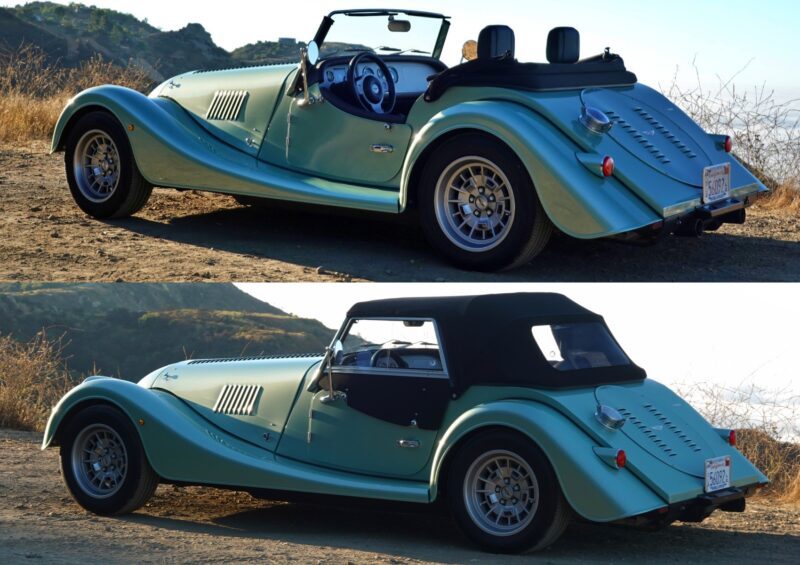
Just don’t ask about climbing in and out, which simply cannot be done without a bit of awkwardness. There’s no real armrest on the doors, either, and the pedal box barely fit my size 10 shoes – imagining a clutch pedal squeezed in, I began to appreciate the automatic transmission a little more. The steering wheel adjusts up and down, without telescoping in and out, but I found the seats ride low enough to create plenty of headroom with the convertible top in place. Matching the exterior, the optional Comfort Plus seats hew more toward a classic cruiser mentality rather than a hardcore sports car.

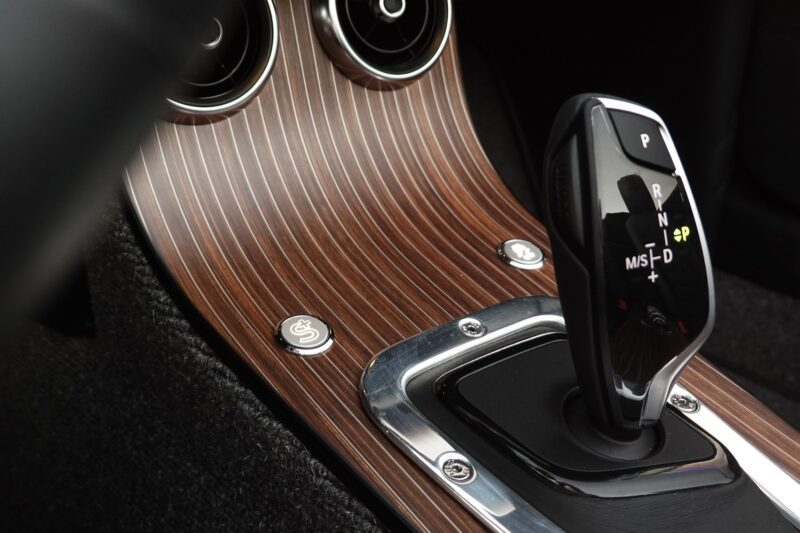
And yet, the lightweight chassis makes driving the Plus Four anywhere near the limit a ton of fun. Modern supercars with the power-to-weight ratios of racecars (or better) are one thing, but a lightweight and low-slung sports car with just the right amount of power can nonetheless feel exponentially faster. Not just because sitting so close to the ground creates a forced perspective, but because cornering and braking require so much less grip to hold and haul down legitimate pace. All while the BMW inline-four churns out a mirthful soundtrack, turbo spooling up and exhaust overrun burble from the exhaust pipes that seemed to stick out immediately behind my skull.
The auto transmission even works fairly well, even if it’s not as snappy as a dual-clutch and prefers stately driving more than hard charging. But skipping the manual here in the United States absolutely misses the mark. Sure, take rates for stick shifts in the U.S. pale in comparison to Europe – but this car’s target customer base is a self-selecting sample that clearly wants something out of the ordinary, rather than a commuter EV or a more modern sports car.
Modernized, Yet Timelessly Classic
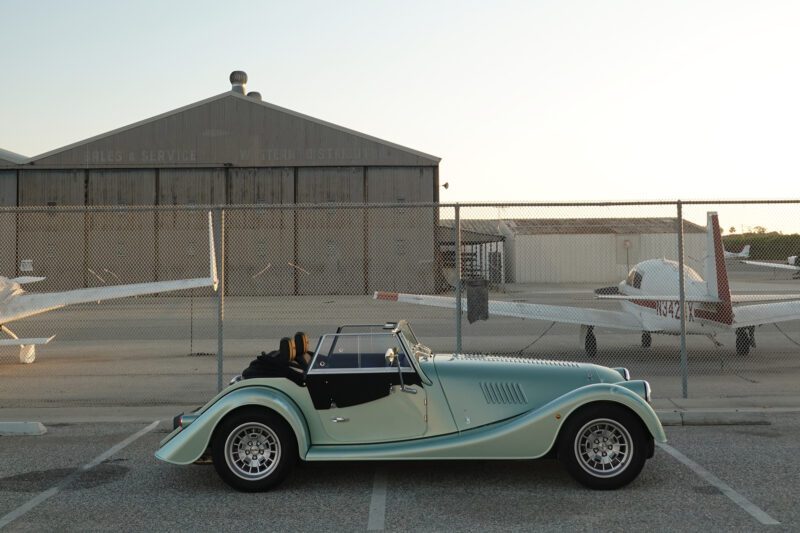
The first time I pulled away in the Plus Four, I marveled at how battened down the chassis feels. Cracks in the road and speed bumps created no suspension clunks or wobbles, quite an impressive feat for a car so small that it’s built using wood. Plus, with so little weight over the rear, the Plus Four happily chirped the tires loose between shifts up to third gear once I popped the horrific BMW shifter to the left for Sport mode.
That futuristic, angular design looks entirely out of place here – even more so than in an Ineos Grenadier. Selecting Sport+ then requires pushing a much more pleasing metal button ahead and to the left on the walnut center console, and I regularly held down the mirrored ESC button to fully turn off traction control intervention. This brought up a small warning on the mildly configurable digital gauge screen, another concession to modernity that seems slightly out of place in something otherwise analog.


This particular Morgan arrived in America equipped with the Dynamic Handling Pack, a $2,410 option that adds adjustable shock dampers, a rear sway bar, and marginally stiffer rear springs. In its factory setting, the suspension tuning perfectly bridges the gap between firm and compliant – simultaneously comfortable enough for daily life but also stiff enough to handle hard cornering in canyons. With a bit more mass from the engine out front, the rear sway bar in particular contributes to a happy propensity toward easily controlled slides, which give way to oversteer in a satisfying and communicative transition while whipping through consecutive curves.
The Plus Four serves as yet another reminder that having slightly more power than tire traction makes driving a ton of fun. Sure, modern sports cars and supercars can go right ahead and chase lap times with those enormous tires on enormous wheels, Morgan seems to say. Instead, the Plus Four sticks with a scant set of 205-millimeter Avons mounted on 15-inchers that reminded me of Campagnolo wheels on Maseratis from the late-1970s and early-80s.
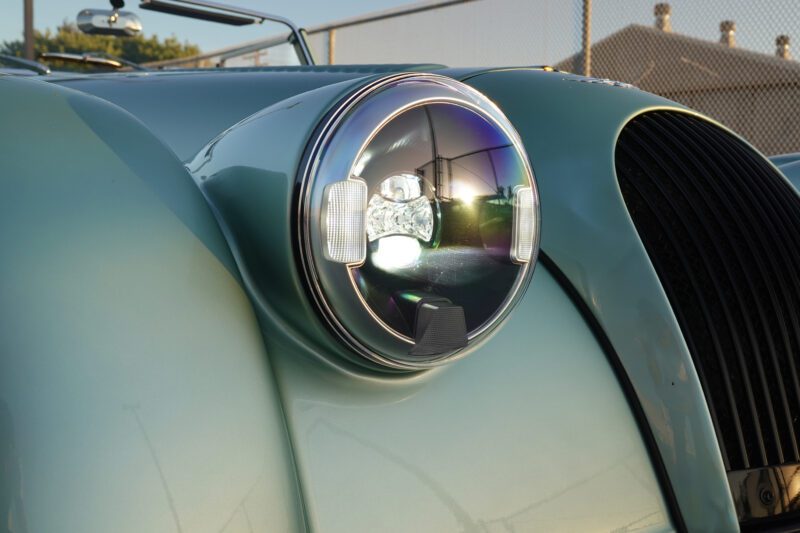



As surprisingly well as it drives, the Plus Four nails the classic style even better. Ice Green metallic paint absolutely glistens, highlighting every swooping curve from every angle. I’d still take a little spare tire on the rear decklid, though, and the profile definitely looks best with the top laid back and the side panels removed – from both a design standpoint and the driver’s perspective. I removed the side panels almost immediately, using a little tool on the key ring to loosen metal knobs on the exterior of the doors. A carrying case then protects the glass and leather from damage, though the whole package doesn’t quite fit behind the seats nicely.
Morgan clearly invested a ton of time and effort into developing the new bonded aluminum chassis, as confirmed by the impressive ride quality. But a close eye on build quality is also clearly reveals some smaller details that went overlooked, in addition to where to store the door panels: one glued-on leather panel already detaching from a door, a hilarious lumbar support system actuated by flimsy hand pumps zip-tied in front of the lower seat cushion, nice metal dials for the climate control and volume that were unfortunately designed in such a way that the decals becomes meaningless once spun around in any direction.
Worst of all, the sun visors mount to the top of the windshield surround with a long Allen bolt and spacer, but no rubber washers or dampers of any kind. So, any smallest reverberation from the road or wind caused horrific rattling directly in front of my face on every single drive. On my own car, I would remove and replace this tiny yet unignorable annoyance, but that’s not exactly the kind of thing I want to be doing with my brand-new six-figure toy.
Morgan Plus Four: Conclusions

I gave back the Morgan, sad to see it go. Over the course of the loan, I increasingly grew comfortable daily driving around big pickup trucks and SUVs with tires that rode about as high as my shoulders. There’s simply nothing else new quite like the Plus Four on American roads, as lightweight sports cars increasingly go extinct. And the style truly elevates the Morgan into a class of one: this little British roadster turned more heads than any car I’ve ever driven bar none, including Ferraris, Lamborghinis, Bugattis, and more!
Imagining a Plus Four in the driveway next to a G-Wagen (or a Grenadier, for that matter) sure seems like a perfect two-car solution for daily life and weekend fun. Such a unique, bespoke character makes the base price of $84,995 seem fairly reasonable, though my tester ramped up to $103,970 as optioned. Most importantly, all the attention the Plus Four received from pedestrians and other drivers brought a smile to everybody’s face, not just mine, as I ripped around town, despite lamenting the lack of a manual transmission, which would simply take the cake.



